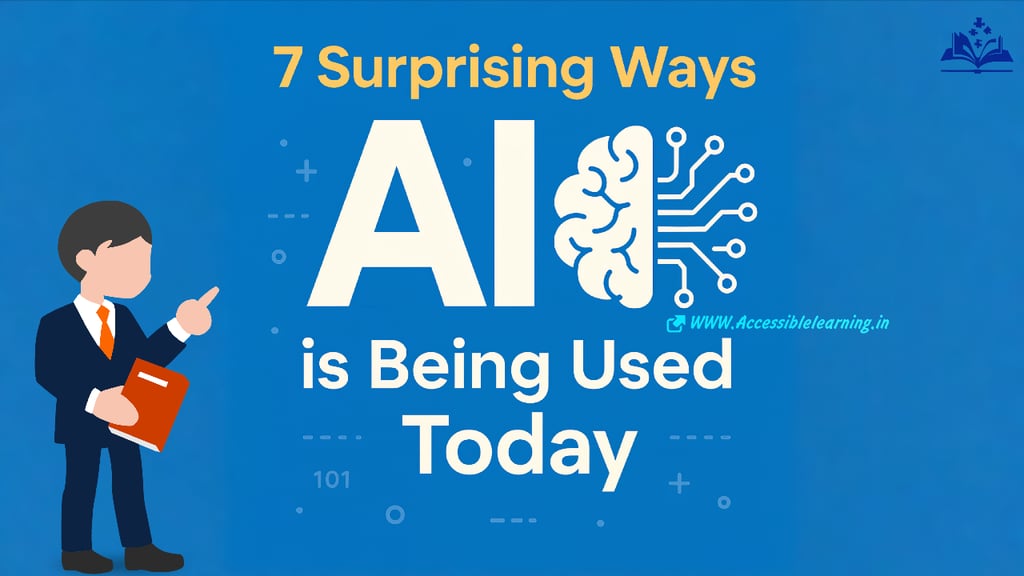
7 Surprising Ways AI is Being Used Today
Discover how artificial intelligence is transforming unexpected areas like farming, fashion, mental health, and more. Explore 7 surprising real-world uses of AI that go beyond the obvious.
HEALTH/DISEASEMODERN DISEASESAI/FUTUREEDUCATION/KNOWLEDGE
Sachin K Chaurasiya
4/29/20254 min read


When most people think of artificial intelligence, they picture self-driving cars, smart assistants like Siri, or robots in futuristic movies. But AI has quietly been making its way into areas of our lives that might truly surprise you. From agriculture to mental health, this intelligent technology is reshaping the world in remarkable and unexpected ways.
In this article, we’ll explore seven surprising uses of AI that go far beyond the headlines—and show just how deeply it's influencing our everyday experiences.
AI in Farming: Precision Agriculture
You might not expect AI to have a place in the soil, but it’s revolutionizing modern farming. Precision agriculture uses AI algorithms to analyze satellite imagery, monitor crop health, detect pests, and even predict weather patterns. It’s not just about machines; it’s about empowering farmers with insights that make every seed count.
Farmers are now able to:
Identify nutrient deficiencies in plants through real-time image analysis
Optimize irrigation systems using AI-powered soil moisture sensors
Use autonomous tractors and drones for precision seeding and pesticide application
Analyze historical and current weather trends for better crop planning
The result? Higher yields, reduced waste, and a more sustainable approach to feeding the world.
AI in Detecting Art Forgeries
The art world is known for its elegance—and, unfortunately, its forgeries. But now, AI is playing the role of a digital detective. With computer vision and machine learning, AI can scrutinize brushstroke patterns, chemical compositions, and even tiny pigment details that human eyes may miss.
Notable uses include
Authenticating historical paintings with millimeter-level accuracy
Comparing new works with an artist’s known style using pattern recognition
Using X-ray scans and deep learning to uncover painted-over artworks
Museums, auction houses, and private collectors now use AI as an invisible guardian of authenticity—bringing transparency to a historically opaque market.
AI for Wildlife Conservation
In the wild, AI is becoming a silent partner to conservationists. Using AI-powered camera traps, satellite monitoring, and acoustic sensors, researchers are now able to track animals, detect threats, and make proactive decisions to protect endangered species.
Key applications:
Identifying animal calls and movements from thousands of hours of audio
Tracking endangered species via drone footage with real-time AI analysis
Predicting poaching patterns to deploy rangers more effectively
Monitoring deforestation and habitat loss via satellite AI detection
AI is helping conservation teams do more with fewer resources—and giving nature a much-needed technological ally.
AI in Mental Health Support
This is one of the most compassionate and promising uses of AI. With mental health needs rising globally, AI is stepping in to offer non-judgmental, always-available support.
Innovative tools like Woebot, Wysa, and Youper offer:
Conversational AI that checks in on your mood and emotions
Cognitive Behavioral Therapy (CBT)-based guidance and exercises
Emotional journaling with pattern recognition to track progress
Resources for mindfulness, anxiety, and stress management
What’s remarkable is how AI enables people to get help privately, instantly, and often for free. It’s not a therapist replacement—but it’s a supportive friend when no one else is around.
AI in Fashion Design and Styling
Fashion is no longer just about fabric—it's about data. AI is transforming how clothes are designed, made, and sold. Brands are now integrating machine learning to stay ahead of trends, reduce overproduction, and create personalized experiences.
Here’s how it’s being used:
Generative AI designs unique garments from scratch based on customer preferences
Virtual stylists suggest outfits based on your body type, weather, and calendar
AI tracks fashion trends across social media to inform next season’s collection
Smart mirrors in stores give style suggestions in real time
From runway to retail, AI is turning fashion into a responsive, tech-savvy experience.
AI in Disaster Response
In emergencies, seconds matter. AI is making crisis response faster, smarter, and more coordinated. By analyzing vast amounts of real-time data, AI helps predict, detect, and respond to disasters before they escalate.
Examples include:
Predicting hurricane paths with astonishing accuracy using deep learning
Identifying collapsed buildings in real-time from satellite images
Deploying drones equipped with AI to locate survivors in hard-to-reach areas
Using chatbots to communicate with people during mass evacuations
AI isn’t just helping after a disaster—it’s actively working to prevent and mitigate them, potentially saving thousands of lives.
AI in Legal Systems: Robo-Judges and Smart Contracts
It might sound futuristic, but AI is quietly transforming the legal landscape. While it won’t replace human judges anytime soon, AI is helping to automate tedious legal work and improve access to justice.
Real-world uses:
Analyzing thousands of legal cases to find precedents in seconds
Drafting legal documents, contracts, and wills with remarkable accuracy
AI judges settling minor disputes online through automated arbitration
Smart contracts executing agreements automatically on the blockchain
These innovations are making legal services faster, cheaper, and more accessible—especially for those who couldn’t afford them before.


FAQs
How is AI used in industries outside of technology?
AI is increasingly being used in sectors like agriculture, healthcare, fashion, and education. For instance, AI helps farmers predict crop diseases, supports doctors in faster diagnoses, and even assists fashion brands in designing sustainable collections.
Can AI really improve mental health treatment?
Yes! AI is helping mental health professionals by analyzing speech patterns, facial expressions, and even social media behavior to detect early signs of depression, anxiety, and other conditions, making early intervention possible.
How is AI impacting the environment positively?
AI tools are helping tackle environmental issues by monitoring deforestation, optimizing renewable energy usage, predicting natural disasters, and creating smarter ways to conserve water and reduce carbon emissions.
Are AI-driven innovations in art and creativity reliable?
Absolutely. AI is being used by artists, musicians, and writers to co-create innovative pieces. While it doesn’t replace human creativity, it acts as a powerful tool to enhance ideas and streamline the creative process.
Will AI completely replace human jobs in these surprising sectors?
Not entirely. In most cases, AI is designed to assist rather than replace humans, taking over repetitive or data-heavy tasks while allowing humans to focus on more complex, creative, and decision-driven roles.
From helping farmers in the field to offering a digital hand in mental health, AI is no longer confined to labs or tech giants. It’s actively reshaping industries and enhancing lives in ways we never imagined.
As AI continues to evolve, so will its influence—and these surprising use cases are just the beginning. What may seem like science fiction today could be standard practice tomorrow.
Curious about where AI might show up next? Keep an eye on the fields, the forests, your wardrobe—and even your inbox. The future is not coming. It’s already here.
Subscribe To Our Newsletter
All © Copyright reserved by Accessible-Learning Hub
| Terms & Conditions
Knowledge is power. Learn with Us. 📚


